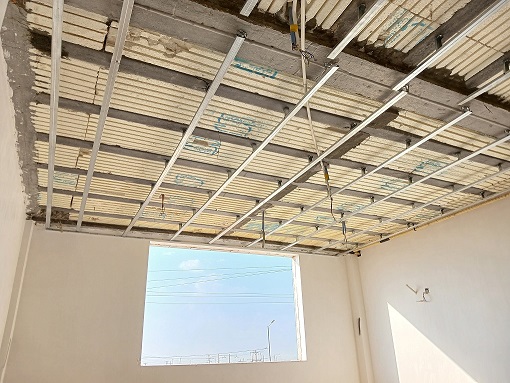? What is Dropped Ceiling
Preparation of the text: AZIN ASIA Research Unit of (Azin Asia Holding company)
A dropped ceiling, also known as a false ceiling, suspended ceiling, or T-bar ceiling, is a secondary ceiling that is installed below the main (structural) ceiling of a room or building. This type of ceiling system creates a space between the main ceiling and the suspended ceiling, which is often used for various purposes such as concealing electrical wiring, plumbing, ductwork, or other utilities.

Note : At AZIN ASIA Holding Company, we supply metal profiles for false ceilings and false walls with the best materials.
Key Features of Dropped Ceilings:
Suspended Grid System: Dropped ceilings typically consist of a grid of metal channels that are suspended from the structural ceiling using wires. The grid forms a network of squares or rectangles where ceiling tiles are placed.
Ceiling Tiles or Panels: The suspended grid is filled with lightweight tiles or panels, which can be made from materials such as gypsum, mineral fiber, PVC, metal, or wood. These tiles are easily removable to provide access to the space above for maintenance.
Space for Utilities: The gap between the main ceiling and the dropped ceiling, known as the plenum space, is used to hide wiring, HVAC ductwork, fire sprinklers, and lighting fixtures. It also makes it easier to install or modify utilities without disturbing the visible ceiling.
Aesthetic Improvement: Dropped ceilings can hide imperfections in the original ceiling, making the interior space look more finished and uniform. They also offer soundproofing and thermal insulation.
Lighting Integration: Dropped ceilings are ideal for integrating recessed lighting fixtures, fluorescent lights, or LED panels, offering flexibility in lighting design.
Acoustic Properties: Many dropped ceilings use acoustic ceiling tiles that help absorb sound, making them popular in offices, schools, and commercial buildings to reduce noise levels.
Common Uses of Dropped Ceilings:
Offices: Dropped ceilings are commonly used in office spaces to allow for easy access to wiring and air conditioning systems.
Commercial Buildings: In retail stores, hospitals, and schools, they offer a neat appearance while providing space for hidden systems.
Basements: Dropped ceilings are popular in basements for their accessibility and ease of installation.
Theaters and Auditoriums: Acoustic tiles in dropped ceilings help improve sound quality.
Advantages of Dropped Ceilings:
Concealment of Utilities: Electrical cables, air ducts, and pipes can be hidden from view.
Easy Access: Maintenance and repairs to the hidden systems can be done by simply removing ceiling tiles.
Acoustic Control: Helps reduce noise through the use of sound-absorbing materials.
Energy Efficiency: The reduced ceiling height can improve heating and cooling efficiency in large rooms.
Customization: A wide range of design options, including different textures, colors, and materials.
Disadvantages of Dropped Ceilings:
Reduced Height: Dropped ceilings lower the height of the room, which might not be suitable for spaces with low original ceilings.
Durability: Some types of ceiling tiles are not very durable and may become damaged over time.
Moisture Damage: In humid environments, certain types of ceiling tiles (especially fiber-based ones) can be susceptible to moisture damage or mold.
In summary, dropped ceilings are a practical and versatile solution in both commercial and residential settings, offering aesthetic benefits and functionality, particularly for spaces that require access to utilities and improved acoustics.
...All about Dropped Ceiling
A dropped ceiling, also known as a false ceiling, suspended ceiling, or T-bar ceiling, is a secondary ceiling hung below the structural ceiling of a room. It's widely used in both commercial and residential spaces for practical and aesthetic purposes, providing an additional layer to the ceiling that allows for the concealment of utilities and improving the overall appearance of the space.
Here’s an in-depth look at everything related to dropped ceilings:
1. Structure and Components
A dropped ceiling is composed of several key components:
a. Suspension System (Grid)
Main Tees (Main Runners): These are the primary structural elements of the grid system. They run the length of the ceiling and are attached to the building’s structure using suspension wires.
Cross Tees (Cross Runners): Shorter sections of the grid that run perpendicular to the main tees, creating a grid pattern of squares or rectangles.
Wall Angles (Perimeter Moldings): Installed along the perimeter of the room, these angles provide support for the edges of the ceiling tiles and the grid system.
Hangers and Wires: These are used to suspend the grid system from the structural ceiling. They are typically made of steel or other durable materials.
b. Ceiling Tiles (Panels)
These are lightweight, decorative tiles that fit into the grid. Tiles come in various sizes, with the most common being 24"x24" (600x600 mm) and 24"x48" (600x1200 mm).
Materials: Ceiling tiles are made from various materials such as gypsum, mineral fiber, fiberglass, PVC, metal, and wood.
c. Plenum Space
The gap between the structural ceiling and the dropped ceiling is called the plenum space. This area is used to run HVAC ducts, electrical wiring, and plumbing pipes. It also allows for easy access to these systems for maintenance and repairs.
d. Light Fixtures and Vents
Dropped ceilings often integrate light fixtures such as fluorescent lights, LED panels, or recessed lights. Air vents and HVAC systems are also commonly installed within the dropped ceiling grid.
2. Types of Dropped Ceilings
There are several different types of dropped ceilings, depending on the material used and the purpose they serve:
a. Acoustic Ceilings
These are designed to improve sound absorption and reduce noise levels in a room. Acoustic ceiling tiles, made from mineral fiber, fiberglass, or foam, help control echo and sound transmission, making them popular in office spaces, schools, and auditoriums.
b. Drywall Ceilings
A drywall or gypsum board ceiling is a solid, continuous surface suspended from the structural ceiling. It can be finished with paint or other treatments and is often used for a more permanent look compared to tile ceilings.
c. Metal Ceilings
Metal dropped ceilings are made from materials such as aluminum or steel and are often used in modern, industrial, or commercial designs. Metal tiles can be perforated for acoustic control or left solid for a sleek appearance.
d. PVC Ceilings
Polyvinyl chloride (PVC) tiles are lightweight, moisture-resistant, and come in a variety of designs. They are often used in areas prone to moisture, such as kitchens, bathrooms, or basements.
e. Coffered Ceilings
This is a type of decorative dropped ceiling where panels are recessed in a grid pattern, creating a series of squares or rectangles. Coffered ceilings add architectural interest and depth to a room.
3. Installation Process
The installation of a dropped ceiling involves the following steps:
a. Preparation
Measure the room's dimensions to determine the amount of grid material and tiles needed. Mark the height at which the ceiling will be installed.
b. Installing Perimeter Molding
Install wall angles (perimeter molding) around the room at the desired height. This will provide a frame for the ceiling grid.
c. Suspending the Grid
Attach hanger wires to the structural ceiling. These wires will support the main tees (runners) of the grid. Ensure the grid is level.
d. Assembling the Grid
Attach the main tees and cross tees to form the grid. The grid should be aligned and supported by the perimeter molding and hanger wires.
e. Placing Tiles
Once the grid is securely in place, insert the ceiling tiles into the grid spaces. Tiles should fit snugly but can be easily removed for access to the plenum space.
f. Installing Lighting and Fixtures
Light fixtures and HVAC vents can be placed within the grid system, replacing specific tiles or integrated into the tile design.
4. Advantages of Dropped Ceilings
a. Aesthetic Appeal
Dropped ceilings can conceal unsightly wiring, ducts, pipes, and imperfections in the structural ceiling, creating a clean, uniform appearance.
b. Easy Access
Ceiling tiles can be removed easily, providing quick access to the plenum space for maintenance or repairs without disturbing the overall structure.
c. Soundproofing
Acoustic tiles help reduce noise levels in spaces, especially useful in offices, classrooms, or any area where sound control is important.
d. Fire Safety
Fire-rated ceiling tiles can be used to improve fire resistance in a building, adding an extra layer of protection.
e. Thermal Insulation
Dropped ceilings help trap air between the main ceiling and the false ceiling, which can improve energy efficiency by providing insulation.
f. Cost-Effective
Compared to other ceiling treatments, dropped ceilings are relatively affordable and can be installed more quickly.
5. Disadvantages of Dropped Ceilings
a. Reduced Room Height
Dropped ceilings lower the overall height of the room, which may be undesirable in spaces where the original ceiling is already low.
b. Durability
Some types of ceiling tiles, especially those made of fiber, can be prone to damage from moisture or impact. Sagging or warping can occur if the tiles are not properly maintained.
c. Moisture Issues
In humid or damp environments, certain materials (like mineral fiber) can be susceptible to moisture absorption, leading to mold or mildew growth.
d. Aesthetic Limitations
While dropped ceilings are practical, they may not offer the same high-end appearance as more sophisticated ceiling finishes like coffered ceilings, tray ceilings, or exposed beams.
6. Materials Used in Dropped Ceilings
a. Gypsum (Drywall)
Gypsum tiles are fire-resistant and provide a clean finish. They are commonly used in offices and commercial spaces.
b. Mineral Fiber
Mineral fiber tiles are popular for their acoustic properties and affordability. They are widely used in schools, hospitals, and offices.
c. PVC (Polyvinyl Chloride)
PVC tiles are moisture-resistant, lightweight, and often used in bathrooms, kitchens, and basements.
d. Metal
Aluminum and steel tiles are durable, fire-resistant, and provide a modern aesthetic, commonly used in commercial or industrial settings.
e. Wood
Wood tiles or panels offer a luxurious and natural appearance, often used in residential spaces for a more decorative and classic look.
7. Applications of Dropped Ceilings
a. Commercial Buildings
Offices, shopping malls, and hospitals frequently use dropped ceilings for aesthetic, acoustic, and functional purposes.
b. Residential Homes
Dropped ceilings are common in basements, kitchens, and bathrooms to conceal wiring and plumbing, or as an aesthetic choice.
c. Educational Institutions
Schools and universities utilize acoustic ceiling tiles to manage noise in classrooms, libraries, and auditoriums.
d. Healthcare Facilities
Hospitals and clinics use dropped ceilings with integrated lighting and ventilation systems for easy access and cleanliness.
e. Theaters and Auditoriums
Acoustic tiles are used in theaters to improve sound quality and control noise.
8. Modern Trends in Dropped Ceilings
Decorative and Textured Tiles: Textured and patterned tiles provide a more appealing look, enhancing the visual aesthetics of a space.
Sustainable Materials: Eco-friendly ceiling tiles made from recycled materials are becoming more popular in green building projects.
Integrated Lighting and HVAC Systems: Advanced systems integrate lighting, heating, and cooling directly into the ceiling grid for a seamless appearance.
9. Maintenance
Dropped ceilings require regular maintenance to keep them in optimal condition. Tiles should be cleaned and inspected for damage, especially in environments prone to moisture. Replacing damaged tiles and checking for leaks in the plenum space is essential to ensure the longevity of the ceiling system.
In summary, dropped ceilings are a versatile, practical, and widely used solution in construction, offering benefits such as utility concealment, easy access for maintenance, soundproofing, and energy efficiency. Their adaptability in different materials, styles, and applications makes them a popular choice for both residential and commercial buildings.
https://www.linkedin.com/pulse/what-dropped-ceiling-reza-habibi-zadeh-99vrf
AZIN ASIA Holding Company, as the most reliable manufacturer and supplier of false ceiling metal profiles and related fittings in Iran, announces its readiness to supply your orders and export these products to your country.
989120896902+
986142288360+
986142288361+




